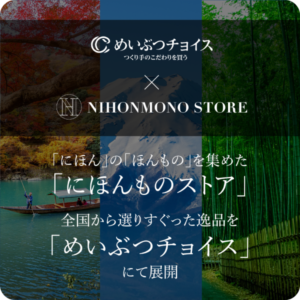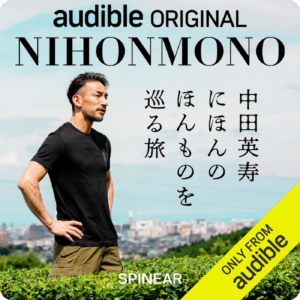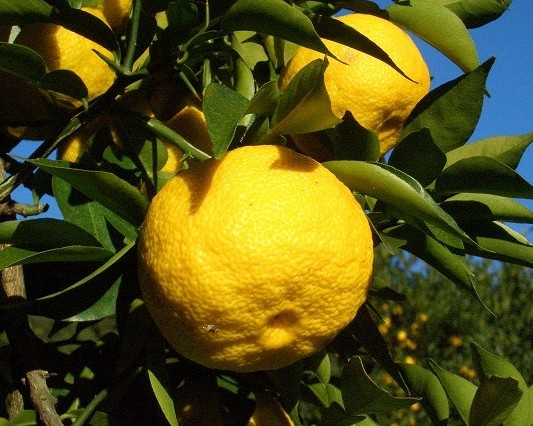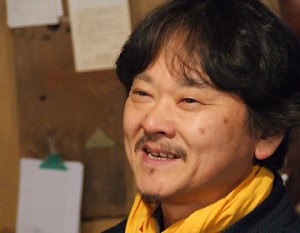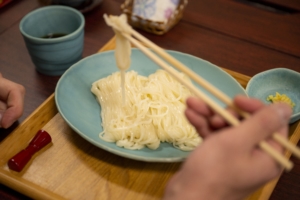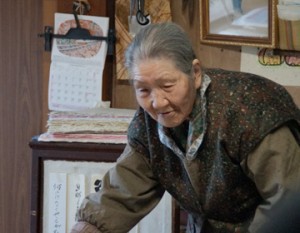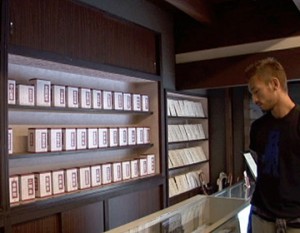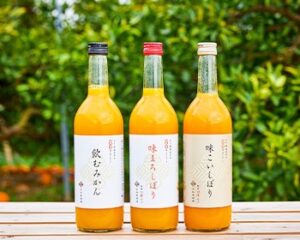Yuzu (a type of citrus fruit) turns yellow in the fall and winter. The “Miya Yuzu” cultivated in Nissatomachi, Utsunomiya City, is highly regarded by chefs at famous restaurants for its rich flavor. Yuzu is widely grown in western Japan, but what is the difference between the yuzu grown in the northern Kanto region? We visited the Tokoi Yuzu Orchard, which grows the Miya Yuzu.
Growing yuzu in the cool climate of northern Kanto

Nissatomachi is located in the northwestern part of Utsunomiya City. Surrounded by mountains on three sides, most of the area is mountain forest. On the plains, agriculture thrives, and the town is famous for its taro and Niisato-negi, a traditional Japanese leek that has been cultivated since the Edo period (1603-1868).
The Tokoi Yuzu Orchard is located in Nissatomachi. The yuzu trees are planted and 10 tons of yuzu fruit are grown here, and after harvesting, the fruit is processed at the farm’s facilities.
100 Yuzu trees planted by my father
The farm is managed by Mitsuo Tokoi, the representative of the company. Tokoi’s father, Tadao, planted 100 yuzu trees in 1964. During the period of rapid economic growth after World War II, the company focused on yuzu, whose aroma could be enjoyed not only for eating but also as a luxury item, to meet the changing tastes of the people. They tried to make this region a production center.
However, yuzu, a citrus fruit, is best suited for cultivation in warmer regions. Even today, Kochi Prefecture accounts for more than half of yuzu production, followed by Tokushima and Ehime prefectures, and the majority of yuzu production is in warmer western Japan. Even at that time, no farmers in the prefecture were engaged in full-scale cultivation, and they received guidance from pioneers in Kochi and Saitama prefectures.
After repeated trial and error, the first shipment was achieved in 1974 (Showa 49), the 10th year of cultivation. However, as more and more yuzu from the warmer regions of western Japan began to be distributed in the Kanto region, the price of yuzu began to be beaten down.
However, as more and more yuzu trees from the warmer regions of western Japan began to be distributed in the Kanto region, prices began to be haggled over. In Mr. Tokoi’s words, “the competition between production areas was losing out.
Yuzu is something you put in the bath?

Under very difficult circumstances, his father Tadao passed away in 2010, and Mr. Tokoi decided to take over the farm. At that time, the only thing on Mr. Tokoi’s mind was “I have to protect this area. At the time, yuzu cultivation was no longer profitable at all. Even locals felt that yuzu was just something to put in the bathtub, so it could only be sold for two or three bounties.
Therefore, we have to communicate more widely about yuzu. Thinking that they needed to do more PR, they decided to focus their efforts on “proposing ways to eat and use” yuzu.
Therefore, Mr. Tokoi and other yuzu growers in the same area joined hands to change the name of the company from “Nissato Yuzu Production and Shipping Association” to “Utsunomiya Yuzu Association,” with the aim of creating a regional brand under the name “Miya Yuzu.
Converting thick-skinned yuzu characteristics into “attractiveness
Yuzu grown in warm regions are characterized by their high juice content. Yuzu grown in cooler climates, however, are slightly smaller and have thicker skins. However, the thickness of the skin is what makes the “Miya Yuzu” so attractive.
The yuzu peel is said to contain a large amount of vitamin C, hesperidin, limonene, and other ingredients that improve blood flow. Furthermore, yuzu aroma components are contained in large quantities in the peel, so yuzu with thick skins have a stronger aroma.
At Tokoi Yuzu Orchard , yuzu is almost never shipped fresh. The yuzu is harvested fresh and 90% of it is frozen and shipped as processed products. In addition to the dressing, yuzukosho (yuzu pepper), and yubeshi (yuzu bean paste) for general consumers, the company often sells frozen sliced peels, powder, juice, and other primary processed products to hotels and restaurants.
Of course, sales were not smooth from the start. During business negotiations with chefs and companies that wanted to use yuzu, we interviewed them about how they wanted to use it and what kind of processing would make them use it, and then we applied the information to our products. By repeating this process over and over again, the number of customers who would buy our products increased. This in turn led to more requests for new uses, which in turn were further utilized in product development.

The company also produces yubeshi, a delicacy that has been made in Japan since the 11th century and has a long history, although it is sold only to a few hotels and JR Shikishima due to the time and labor required to produce it in large quantities.
Locally, yuzu was only known as “something you put in the bath in winter,” but “it was only after we went through the primary processing that a match was made,” smiles Mr. Tokoi.
Experiencing foreign evaluations gave me confidence.
Yuzu is said to have originated in the upper reaches of the Yangtze River in China and was introduced to Japan around the Nara period (710-794). Currently, Japan is the world’s largest producer of yuzu, which is also cultivated in China, Korea, Australia, Spain, Italy, and France, but Japanese yuzu is characterized by its high aroma compared to yuzu from other countries.
In 2018 and 2019, Mr. Tokoi was approached as part of a project by the government to expand sales channels for Japanese food overseas, and he traveled to Paris, France. There, Mr. Tokoi was truly surprised to learn that “Japanese yuzu is so highly regarded in France! Mr. Tokoi was truly surprised at how well Japanese yuzu was received in France.
When he visited Bangkok, Thailand, Mr. Tokoi wondered if Thai people could understand the taste of yuzu, but there, too, he felt that “Thai people take yuzu very seriously.
He was told that there were about 20 yuzu specialty stores in Thailand, which gave him confidence as well as the realization that “people overseas appreciate yuzu more than Japanese people do.
What we can do because we are a small farm in a rural area

The yuzu trees at Tokoi Yuzu Orchard are short because they are pruned frequently to get more sun and wind. This ensures that the trees bear good fruit and are less susceptible to disease. The fruit is picked while it is still green, and most of it is used to make yuzu kosho. The green yuzu, which has little demand as it is, is not thrown away, but instead is put to good use. Currently, the farm grows two varieties of yuzu. One is the “Honn Yuzu,” which has a strong aroma and a bitter taste typical of yuzu. The other is “Tada Nishiki,” which has a lot of juice like a lemon and no seeds.
The fruits turn yellow around mid-November each year, and are harvested all at once within a month or so. Harvesting is completed before frost. Once harvested, they are processed within two to three days. By shortening the time between harvesting and processing, they are able to maintain a good aroma. This may be because we are a small production center,” says Tokoi. The fact that the cultivation, harvesting, and processing are all done within the reach of his own eyes and hands may be the secret to growing good yuzu.
Yuzu is nurtured by the climate of this land, and we feel like we are helping it grow,” says Tokoi. That is why the catchphrase “36 degrees north latitude Miya Yuzu grown by light and wind” is used as the catchphrase.
We want people to come to the region to learn about Miya Yuzu

Currently, Tokoi Yuzuen’s yuzu is used in many restaurants of first-class hotels such as “The Ritz-Carlton Nikko,” “Nikko Kanaya Hotel,” and “Palace Hotel Omiya. The reputation of the product has been well received, and there are so many offers that the current production volume cannot keep up with the demand.
However, Mr. Tokoi says he has no intention of continuing to produce on a large scale. “I want people to actually see the yuzu orchard and use the yuzu if they understand its qualities,” he says. We are now able to have honest discussions with chefs. In 2024, we will utilize the results of yuzu ingredient research that we have long conducted with Utsunomiya University to create a room fragrance that reproduces the fragrance of Miya Yuzu and an anti-stress fragrance based on the fragrance of Miya Yuzu. The company also released a room spray made with a fragrance that is said to have anti-stress properties, based on the Miya Yuzu fragrance.
The appeal of Miya Yuzu is not limited to food, and will continue to expand.
